
 |
Unlimited Air Racing - Reno 2016
Text and Photos by Dan Whitney
Reno 2016 was a fun event. Great weather, good crowds, lots of airplanes even though the Unlimited field was far from full, with only eleven racers. Even so, there was a lot of good racing in the other divisions, speed records being broken and a lot of action. It was also a safe week, although several aircraft were damaged in runway collisions, and a Vampire jet and a Thunder Mustang were damaged when engine failure resulted in desert landings.
The reduced field of Unlimiteds was organized into two groups, the “Silver” and “Gold,” and the schedule arranged so that each group raced every day, Friday through Sunday.
The Big Picture
This year’s field included five P-51 Mustangs, four Sea Furys, and two Yaks. The only highly modified P-51 this year was Voodoo, as the perennial favorite and last year’s winner Strega was unable to raise funds needed for its annual engine overhaul. Rod Lewis’s Rare Bear and #232 Sea Fury were on static display only, as the issues in the oil fields took priority. Six time Unlimited Champion Steven Hinton again piloted Voodoo. The major competition for Voodoowas #86 Czech Mate, who returned with a new pilot, James Consalvi, after having skipped last year’s races.
Two organizations provided the bulk of the remaining racers. The Sanders Brothers with their stable of three Sea Furys (each with a different type of engine), and the Planes of Fame Museum at Chino who brought their T-33 pace plane and two Mustangs, one being a “real” Allison powered P-51A. Two other P-51Ds, an R-3350 powered Sea Fury, and the R-1830 powered Yak-11 of “Dusty” Dowd completed the field.
Although there was not much “head-to-head” challenging among the top racers, they still put on a good show, had some good lap times, and there was a fair amount of passing as the highly modified racers passed slower airplanes in the same heat. Again, there were no major engine issues among the Unlimiteds, suggesting that they will be working to bring the airplanes back next year.
The Races
The Unlimited course is 8.0851 miles in length. Most of the races are of six laps duration, for a length of 48.01 miles, except on Sunday’s finals, where the Silver is seven laps and the Unlimited Gold race is for eight laps, 64.18 miles. Note that all qualifying and race speeds are tabulated at the end of the article.
While the air racing, and the airshow, begin Wednesday noon, following the final Unlimited qualifying session, the Unlimiteds did not begin to race until Friday. The racing that did go on was among the other classes, particularly those in the “Sport” class, which had a record 41 entries this year.
Friday – Unlimited racing finally got started with the first Silver heat, a matchup of four stock P-51s, Dusty Dowd’s modified Yak-11 and rookie pilot Joel Swager piloting the R-2800 powered Sea Fury Argonaut. Swager won at 381.024 mph, some 17 seconds ahead of the Yak, which finished at 367.385 mph.
The racers started in their qualifying order, and finished the same except that the Allison powered P-51A Mrs. Virginia was in third place, at 344.996 mph, just 0.236 seconds ahead of stable mate P-51D Wee Willy, who clocked 344.834 mph in the six lap race. The last two places were held by P-51Ds Sparky/Blondie and The Rebel, who had a close race, finishing less than a half second apart with speeds of 316.322 and 315.994 mph respectively.
As usual, qualifying order set the lineup for the Gold heat, and this lineup was maintained throughout the race, with Steven Hinton in Voodoo finishing the six lap race in first at 471.703 mph followed by first time Unlimited racer James Consalvi in the R-2800 powered Yak-11 Czech Mate in second at 454.368 mph followed in order by Brian Sanders in the R-4360 powered Sea Fury Dreadnought at 432.821 mph, then Curt Brown in the Sea Fury Sawbones at 419.982 mph and finally Dennis Sanders in the Centaurus powered Sea Fury #924 at 359.295 mph.
Saturday – As a result of his Friday win in Argonaut, Joel Swager moved up to the Gold class for the rest of the week. This left five racers for Saturday’s Silver heat, arranged in the order they had finished the day before, with Dusty Doud in the Yak on the pole. He stayed in front for the win at 372.770 mph, followed by P-51D Wee Willy, then the Mrs. Virginia P-51A at 352.307 and 349.562 mph respectively. Bringing up the rear were the P-51Ds The Rebel and Sparky/Blondie at 334.574 and 306.049 mph respectively. While there were two passes between the P-51s, it appeared to be part of a friendly game, but it did make for some good photos from the pylons. With the exception of Sparky, all of the racers improved on their Friday speeds.
The Gold racers finished as they had on Friday, with the exception of the insertion of Joel Swager in Argonaut, who just finished 0.066 seconds ahead of Dennis Sanders in #924, with a speed of 359.845 mph. Steven Hinton put Voodoo in front at the start and was never challenged, in fact reducing power through the race. He still finished at 453.148 mph, a speed that is within the capability of the second place Czech Mate Yak, but there was no point to overtake Voodoo as Hinton could have easily increased his speed. Czech Mate finished at 447.835 mph.
The Sanders brothers, Dennis and Brian, alternate years piloting Dreadnought; this year it was Brian’s turn. Brian did his usual good job and brought the big Sea Fury in at third with a speed of 425.022 mph. He was followed by three more Sea Fury’s, Sawbones (418.545 mph), and the closely spaced Argonaut and #924 in the rear.
Sunday – Again we were blessed with excellent weather for this final day of racing in 2016. The Silver race got off to a good start with Dusty Dowd in the R-1830 powered Yak-11 Lylia starting on the pole and staying way out in front for the whole race, finishing with a speed of 376.174 mph. This was 14 mph faster than he qualified this year and much faster than his qualifying speed of 305.133 mph in 2015. Clearly, his modifications to the airframe, engine and propeller have produced a winner. John Maloney in the P-51A Mrs. Virginia got in front of P-51D stable mate Wee Willy, piloted by Robert Patterson, taking second and third respectively at speeds of 351.602 and 351.182 mph. They were closely followed by P-51D The Rebel, piloted by Doug Matthews, with a speed of 350.342 mph. The final position was taken by Brant Seghetti in Sparky/Blondie, who finished at 321.309 mph.
With his win in the Silver Dowd had an opportunity to “bump” up and compete in the Gold final. However, he elected to take his Silver winnings and let the opportunity pass. As such, there were six racers in the Sunday Gold, the same aircraft as had raced in the Gold the day before.
Finally it was time for the final Gold race of the week, with all of its pageant and ceremony in front of the giant grandstands. The racers took off and formed up on the pace jet and headed for the “chute,” and entry onto the course, led by Steven Hinton Jr. in Voodoo. He clearly started at very high power, but once firmly in the lead did back off, improving the likelihood that he would be in the race at the finish.
The Gold racers finished in the order in which they started, with Voodoo in first at 460.306 mph, followed by Czech Mate, some eleven seconds back, at 450.582 mph. Dreadnought again captured third place, with a speed of 430.137 mph, and was followed by the Sea Furys Sawbones, Argonaut and #924 at speeds of 417.071, 365.061 and 353.025 mph respectively. These last two provided some excitement as they were lapped by Voodoo before they completed lap seven of the eight lap race. An extra hundred miles per hour makes a difference!
The Unlimited Racers
The following descriptions of each airplane are given in the order in which they qualified. See the table at the end of this article for speeds and placement in all of the Unlimited Heats.
 |
#5 Voodoo, a highly modified P-51D powered by an Allison-rodded V-1650 Packard Merlin. Pilot Steven Hinton, Jr. qualified the airplane on Monday with a single lap of 475.027 mph, putting him on the pole for the first Gold heat race. No issues or “gremlins” appeared during the week and all was in readiness for the Friday race. During the Friday race Voodoo was not seriously challenged, winning with a speed of 471.703 mph, with 2nd place Czech Mate finishing some 14 seconds (a quarter of a lap) behind, with a speed of 454.368 mph. The Saturday Gold race had the same result; however it was clear the guys were saving their “stuff” for the Sunday final. Voodoo posted a speed of 453.148 with Czech Mate second at 447.835 mph, but only 0.525 seconds behind in the six lap race. The eight lap Sunday Gold Final was again won by Voodoo, this time with a speed of 460.306 mph while Czech Mate was in second at 450.582 mph, 10.833 seconds behind. Starting from the pole each day, Hinton’s strategy was to enter the course running 110 inHgA manifold pressure and with the engine turning 3,400 rpm. This gave him a commanding lead for the first lap or so, and then he would reduce power by about 10 inHgA every couple of laps. By the end of the race he was running 80 inHgA, with copious amounts of horsepower available should any of the other racers mount a challenge. This strategy minimizes wear and tear on the engine and thereby reduces the cost of preparing the engine for next year. Note that in the past Voodoo has run the engine as high as 142 inHgA and 3,600 rpm, so there is a lot of capability still available. Reno time keepers do not publish the racers individual lap times, however your author was able to develop unofficial speeds for Voodoo during Sunday’s Gold final by using camera EXIF data from images taken each time Voodoo rounded pylon #2. In order, these were 477.15, 462.01, 462.01, 454.79, 454.79 and 441.01 mph, (all accurate to about +/-3.75 mph, the posted average speed for the race was 460.306 mph), which clearly shows Hinton’s steady hand and precise course, as well as the effect of the stepped power reductions. This year’s enhancements to the aircraft were largely related to improving internal systems, specifically the cooling system, as well as reconfiguring the flaps. Historically the team had experienced at least one cracked coolant header tank each year, and last year it caused a Mayday and DNF in the final Gold heat, when about half of the coolant was lost due to another cracked header tank. During the off-season the team adapted a reconfigured coolant system as used by their arch rival Strega. This features removing and discarding the “horsecollar” header tank installed in front of the engine and piping the hot coolant to a new steel header tank located high in the fuselage, directly behind the pilot and aft firewall. To maintain coolant pressure within the cylinder banks, back pressure chokes are fitted at the head outlets, thereby preventing excessive vapor formation. As the coolant is a 50:50 mixture of glycol and water, vapor formation could become a real problem at low pressure. This year the Merlin was built by Vintage V-12s, and featured not only the Allison connecting rods, installed in the positions as given in the Merlin manuals, stock main bearing caps (not steel), and special race pistons with 5.50:1 compression ratio, rather than the 6.00:1 in a stock engine. The reduced compression ratio definitely reduces loads on the bearings and helps keep the bottom of the engine happy. It is also claimed that the lowered compression ratio allows the engine to develop more torque; however it will take the installation of an instrumented drive shaft to know for sure. The propeller reduction gear ratio is 0.420:1, as original on the Merlin transport series engines. |
| Voodoo rounding pylon 2 and in the lead. Just weeks before the election, Voodoo’s owner Bob Button displayed the only political “bumper sticker” seen on any of the racers. At 500 mph, it was definitely the fastest bumper sticker around. | |
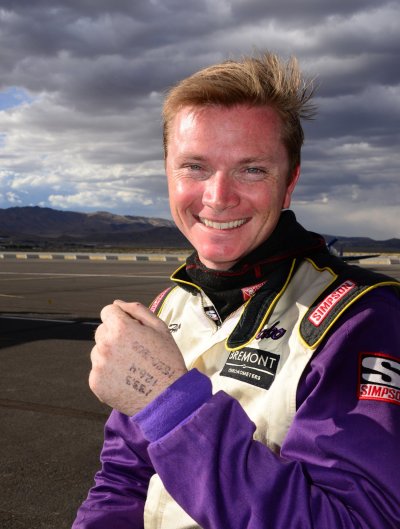 |
|
| Steven Hinton, Jr. won again this year in Voodoo, his seventh time as Unlimited champion. The personable racer is showing the radio info written on his hand following Monday’s qualifying run at 475.027 mph. |
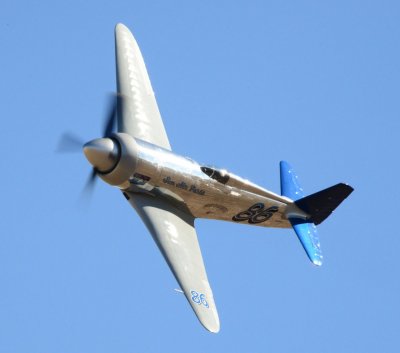 |
#86 Czech Mate. It was good to have this mighty racer back at Reno after skipping 2015, though the new pilot James Consalvi had problems getting to Reno. On the way up the propeller became erratic, with speed fluctuating +/-100 rpm. As a result he set down in Bakersfield. Fortunately, the Sanders Brothers were able to provide a new prop governor, which was quickly flown to him and installed. Consalvi then raced for Stead Field/Reno, getting there a mere 15 minutes before the arrival deadline. The airplanes internal systems had been reworked with the goal being to improve oil cooler effectiveness and reduce the associated cooling drag. On Tuesday Consalvi, qualified the racer at 444.121 mph, very creditable for his first time out in the little beast, which compares to Czech Mate’s best ever of 466.910 mph back in 2009. The racer started life as a Yak-11 trainer, however years of work have evolved it into a highly modified racer, now powered by a Pratt & Whitney R-2800-CB3, modified propeller and supporting systems to match. In the recent past the wing was completely rebuilt to improve its structural capability when the aircraft is operating at speeds well over 450 mph. |
| Czech Mate, piloted by James Consalvi, coming around pylon #2 during Friday’s Gold Heat where he finished in second at 454.368 mph, some 10 mph faster than his qualifying speed. |
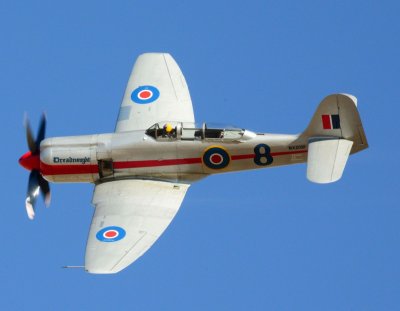 |
#8 Dreadnought, a Sea Fury T.Mk.20, re-powered with a Pratt & Whitney R-4360, piloted this year by Brian Sanders. This big and heavy airplane takes the approach of being pretty, and very dependable. As a result Dreadnought often finishes in the money when one or more of the leaders have problems. Back in 1986 Dreadnought set a new qualifying record at 452.737 mph, so qualifying at 440.432 mph this year did not show the full potential of the racer, though it was better than the 432.860 mph posted last year. During Monday’s qualifying run the engine began to run rough. Overnight the crew found a cracked sparkplug and another fouled. They replaced all 56 plugs, three ignition coils and some leads. No other problems during the week. |
| Brian Sanders during the Sunday Gold Race bringing Dreadnought around pylon #2. He finished 3rd with a speed of 432.821 mph. |
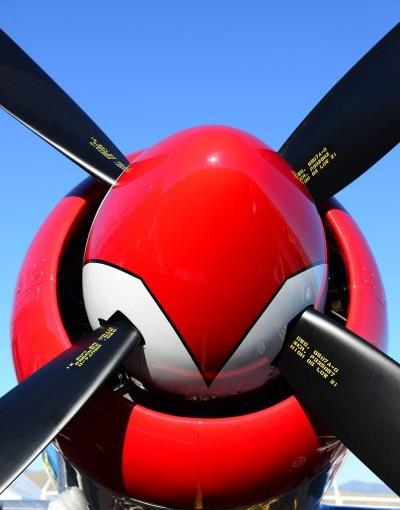 |
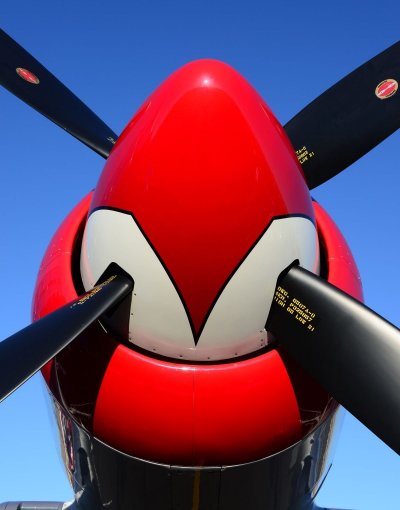 |
#71 Sawbones, was the only Wright R-3350-26WA powered Sea Fury at the races this year. Again flown by Shuttle Astronaut Curt Brown, he qualified at a higher speed than last year 421.318 verses 417.949 mph, but raced at about 417 mph through the week, giving a good solid forth place finish in each of the three days of racing. During the off season the airplanes nose was reconfigured by enlarging the spinner, with the goal of reducing drag. Also, the propeller diameter was reduced from 13’-6” to 13’-1”, although the diameter information painted on the blades was not updated. It appears that the effort was successful, given the increase in qualifying speed; however the amount was not too impressive. |
| R-3350 powered Sawbones, has a new spinner for 2016. Shown on the left is the previous setup, as used in 2015, while the one on the right shows a much smaller area for bringing cooling air in for the engine. This reduces the amount of drag. A close look at the blade serial numbers shows that they are the “same” in both years, however crew members stated that the prop diameter was reduced from the stock 13’-6” to 13’-1”, allowing higher rpm and/or lower drag. | ||
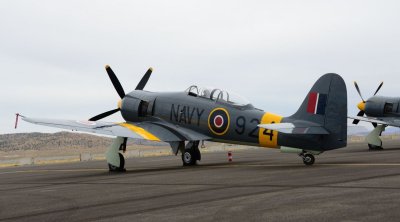 |
#924G.This is a Sea Fury T.Mk.20 powered by an original Bristol Centaurus 18-cylinder sleeve valve engine. This year it was flown by Dennis Sanders, who qualified the racer at 386.154 mph, and in the subsequent Gold heat races finished each in last place. Probably not a bad idea as there was no way the engine/airplane combination was going to be able to challenge any of the other Gold racers. |
| The classic Centaurus powered Sea Fury is seldom seen in the States these days, and is a unique racer. Here #924G being prepared for a qualifying run, looking every bit the classic image of a two-seat Sea Fury. |
 |
#114 Argonaut, a Pratt & Whitney R-2800-CB3 powered Sea Fury FB Mk.11 flown by rookie Joel Swager, who won his first race on the opening day of Unlimited racing. He then bumped up into the Gold for the rest of the week, where he had a close race with Dennis Sanders in #924G on Saturday, but finished well ahead of his Sanders Brothers stable mate in Sunday’s Gold final. During his qualifying runs on Tuesday Swager ran two laps in the 351-353 mph range, which was all the big bird could do as the ADI system was found to not be working. Pete Law investigated and determined that the water regulator was the problem. Fortunately, Czech Mate, the other R-2800 powered racer on the field, also has a Pete Law ADI system and they were able to borrow a spare water regulator. Joel took Argonaut out for the final Unlimited qualifying session on Wednesday and posted a speed of 383.488 mph with everything working, and putting himself on the pole for the Friday Silver heat. |
| Argonaut’s rookie pilot Joel Swager looking on as AEHS member Pete Law digs into the accessory section to diagnose the problem with the ADI/Water regulator on the R-2800. Without water injection the engine is limited to only nominal takeoff power, which is not sufficient to win at Reno. Fortunately, the team was able to borrow a spare water regulator from the R-2800 powered Czech Mate. |
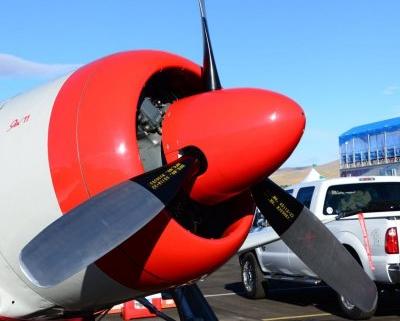 |
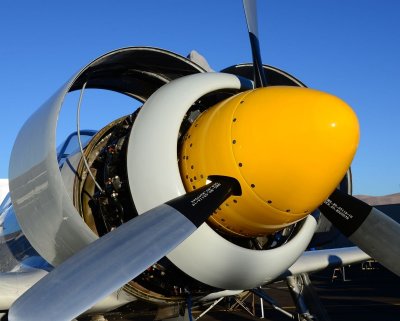 |
#92 Lylia, a Russian Yak-11 fitted with a Pratt & Whitney R-1830 that started life as an improved R-1830-54 as used on late model B-24 bombers. During the off-season a lot of work went into this engine and the airframe. Changes included fitting a new supercharger impeller, a new carburetor, longer propeller blades with pitch changes, and a new exhaust collector with a single outlet under the aft cowling, and an ADI injection system. In addition a bigger spinner was fabricated, resulting in a smaller cooling air inlet slot, as well as a new spinner afterbody to improve airflow. With all of these changes there was a dramatic performance improvement compared to last year, where the airplane qualified at 305.133 mph. This year Lylia qualified at 362.723! This may be the largest year-to-year increase in speed ever seen at Reno. This speed was put to good use, as Lylia finished 2nd in the first heat race and won both of the following races; speeds were 367.385, 372.770 and 376.174 mph respectively. Dusty flew a smooth and low course each day and finished well ahead of the planes following him. |
| Lylia had an entirely new cowling and propeller arrangement that contributed largely to the dramatic increase in race speeds for the modified Pratt & Whitney R-1830-54 powered Yak-11. On the left is the 2015 configuration, while the right image shows the much enlarged spinner and the new afterbody flown in 2016. This greatly reduces drag due to incoming cylinder cooling air. Note also, the propeller diameter has been increased by 4 inches to handle the greater power coming from the modified engine. | ||
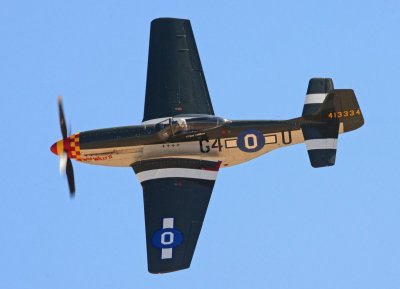 |
#0 Wee Willy, now a stock P-51D Mustang, this airplane carries the serial number of the famous Red Barron, the Rolls-Royce Griffon powered P-51 that at one time held the propeller driven world speed record. The aircraft was provided by the Planes of Fame Air Museum and flown by Robert Patterson. He qualified at 357.594 mph and had three very close races with the Museum’s P-51A Mrs. Virginia, who he was behind on Friday, ahead of on Saturday, and behind in the Sunday Silver final. The difference in times was only 0.236, 3.853 and 0.686 seconds. Wee Willy’s speeds for the three races were 344.834, 352.307 and 351.182 mph respectively. |
| Wee Willy, a P-51D piloted by Bob Patterson swapped positions with P-51A Mrs. Virginia all week, letting the fans see some competitive flying between stable mates from the Planes of Fame Museum. |
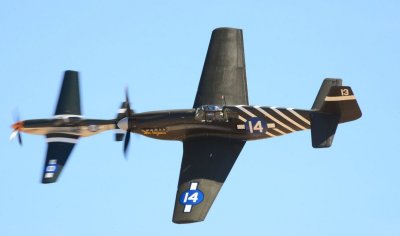 |
#14 Mrs. Virginia, a stock Allison powered P-51A Mustang provided by the Planes of Fame Museum and flown by John Maloney. John qualified the plane at 356.032 mph, much better than the last time this airframe competed at Reno, back in 1981, when it was qualified at 350.400 mph. It was the same V-1710-89 JRS-built engine as raced 35 years ago, but it was run much harder back then, at a reported 75 inHgA at 3,200 rpm. Interestingly, the higher speeds this year were achieved running at 55 inHgA at 2,950 rpm. This replicates a findings on the Polar Bear P-51A a few years ago when a qualifying run using 3,200 rpm was tried and found to result in a slower speed than when running at 3,000 rpm. The problem is the 3-blade Curtiss Electric propeller; it just does not do well at high rpm and high speed. During the week Mrs. Virginia battled it out with the other Planes of Fame competitor, Wee Willy, for bragging rights – or it may have been one of those “it’s my/your turn,” things. In any case the fans got to see two very competitive and differently powered airplanes (Allison verses Merlin) going at it. They sounded, and looked good! |
| Wee Willy, the P-51D, is passing the P-51A Mrs. Virginia on the outside off Pylon #2 during Saturday’s Silver Heat. Lots of fun racing between these two stable mates from the Planes of Fame Museum. |
 |
#44 Sparky/Blondie, a stock Merlin powered P-51D flown by Brant Seghetti. The racer has been repainted for this year, losing its “Jelly Belly” motif and being identified on the port side, as “Blondie,” while the off side retained the previous “Sparky” nose art. Brant qualified his racer at 343.195 mph, much better than the 310.362 mph posted last year and even better than the 329.638 mph posted in 2014. Racing in the Silver heats all week Sparky/Blondie always finished fifth. The only racer he beat was The Rebel on Friday, where he ran 316.322 verses 315.994 mph, a difference of 0.471 seconds. On Saturday and Sunday he finished in last place, with speeds of 306.049 and 321.309 mph respectively. |
| Sparky/Blondie during Saturday’s Silver heat, finishing at 306.049 mph. |
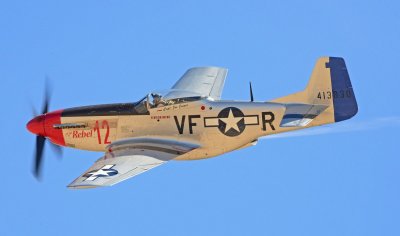 |
#12 The Rebel, a stock Merlin powered P-51D was qualified by Doug Matthews at 342.307 mph, much better than last year’s 303.723 mph. Doug shared piloting duties with John Currenti, who piloted the racer during the Friday and Saturday Silver heats, where he posted speeds of 315.994 and 334.574 mph, finishing in sixth and fourth places respectively. For the Sunday Silver final Doug Matthews was again at the controls and finished in fourth place at 350.342 mph. This race was very competitive between three Mustangs, with the P-51A Mrs. Virginia edging out P-51Ds Wee Willy and The Rebel, their speeds were 351.602, 351.182 and 350.342 mph respectively. |
| The Rebel, a stock Mustang. In Sunday’s Silver final Doug Matthews finished fourth at 350.342 mph. In the same race in 2015 he finished in second at 332.828 mph, so the race speeds were definitely up this year. That’s radiator spraybar water trailing the aircraft. |
The Airshow
This year the Reno race fans were treated to an accompanying air show that featured the U.S. Navy Blue Angels Aerial Demonstration Team. They put on their usual quality performance, though on Thursday and Friday not all of the team members were able to fly due to food poisoning. Still the rest of the team put on their usual outstanding demonstration of precision close formation flying. Fans truly enjoyed the after-burning high performance jets and their gravity defying aerial maneuvers.
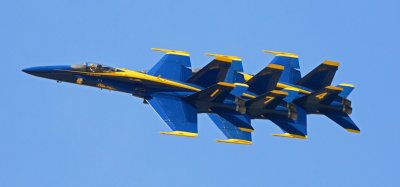 |
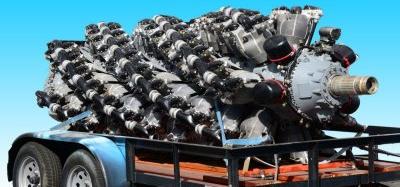 |
| US Navy Blue Angels in their F/A-18 jets performing precision maneuvers at Reno 2016. | It’s not unusual to see unusual thing in the Reno Pits. Here is the famous P&W R-13080, the 84 cylinder, twelve-row, version of their better known R-4360 “Corncob” engine. Master display engine builder Brian Peaden constructed this monster for the enjoyment of race fans. It was interesting to listen to the “experts” telling their friends all about this engine and the airplane(s) it powered! Brian also provided beautiful cutaways of an R-4360 and Bristol Centaurus shown in the lobby of one of the major Reno casinos. |
The Other Classes
There is more going on than just the Unlimited class racing at Reno. In fact there are six racing divisions: Unlimited, Jets, Sport, T-6, Formula and Biplane. In total 132 airplanes this year, up from 119 last year. Air racing is not just popular with the fans, but with the pilots and owners too. With each division typically offering at least two and up to four races each day, there are a lot of airplanes in the sky, and a lot of good racing going on.
 |
 |
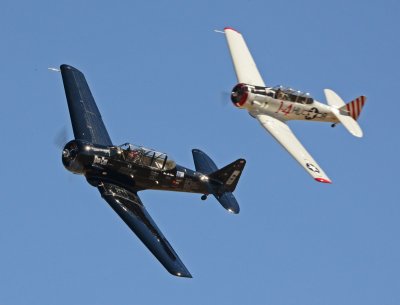 |
| Jeff LaVelle’s Glasair III, #39 qualified at 403.411 mph, and won the Sunday Gold at 383.397 mph, beating second place, John Parker’s Blue Thunder II Thunder Mustang, 371.333 mph, by nearly 15 seconds. With turbochargers and ADI these little airplanes really go. | <L-39C #10 Riff Raff, piloted by David Culler, Jr. inside of Jon Socolof in his Galeb G2-A Soko o’no. Fastest Jet qualifier was an L-39C American Spirit at 513.177 mph. | In the Sunday Gold T-6 Final, Six-Cat and Baron’s Revenge, #14, fought it out with Chris Rushing taking first place in Baron’s Revenge at a speed of 231.193 mph and Nick Macy in Six-Cat 0.178 seconds behind, with a speed of 231.104 mph. The T-6 class has a lot of close and exciting racing. |
 |
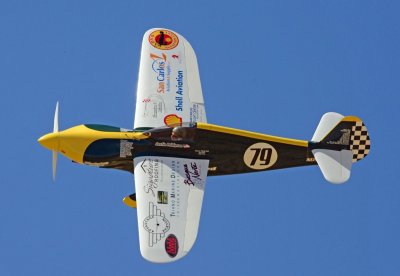 |
| Anthony Oshinuga in his Pitts S-1S Black Hawk Biplane finished 2nd at 186.483 mph in the Sunday Silver. Biplane Gold was won by Jeff Rose in his Mong Sport Reno Rabbit with a speed of 217.858 mph | #79 No Strings Attached, a Shoestring piloted by Justin Phillipson, finished in 3rd place in the Sunday Formula One Gold race at 227.871 mph. Quite the handsome little racer. The race was won by Lowell Slatter in his Gilbert DG2 Fraed Naught at 256.728 mph. |
Racing Technology
Racers are always looking for an edge over the competition. Bill Kerchenfaut, crew chief on a long list of the most successful Unlimited racers, had worked for a number of years to develop an instrumented propeller shaft for the Merlin. His goal was to take much of the uncertainty out of airframe and engine enhancements by actually knowing the horsepower being delivered to the propeller. This was an expensive and technically challenging endeavor, however he had built prototypes.
Walking around the Sport plane pits this year your author found that a solution to this question has been developed, and Tecat Performance Systems was there to support and demonstrate their approach. Their technology uses classic strain gauges bonded to the crankshaft-reduction gear coupling shaft. The secret is that the developed signal is wirelessly transmitted to a receiver mounted in the engine compartment. This eliminates the troublesome “slip rings” previously attempted. The entire package is actually flying in some of the Thunder Mustangs where it and its batteries, are installed inside the coupling shaft. The device is also mounted on Kevin Eldredge’s Relentless NXT. Because the system measures torque 1,000 times per second it is able to see and track the transmitted loads from a single cylinder’s combustion event. Kevin was able to identify instances where a single spark plug was malfunctioning on a seemingly smooth running engine by just observing the erratic stress patterns it caused. This technology has yet to be adapted to the Unlimited racers, but the Merlin and Allison engines are prime candidates due to their configurations. Exciting days ahead.
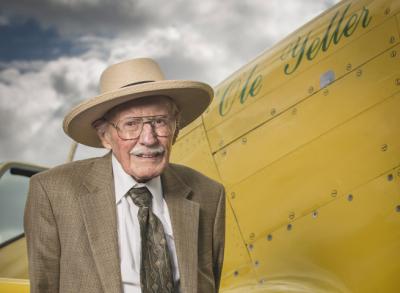 |
Bob Hoover – 1922-2016, RIP On October 25, 2016 the air racing community, and aviation in general, lost one of its pilots with the “Right Stuff;” Robert “Bob” Anderson Hoover. Bob, who was 94 at the time of his passing, is known as the “pilot’s pilot,” had been a patriarch of the Reno Air Races, where for decades he was the pace and safety pilot for the Unlimited Division. His words, “Gentlemen, you have a race,” are legendary. He was a true gentleman and friend to all. During his last couple of years he was instrumental in assisting the Aerospace Museum of California in its STEM program, focusing on exciting, motivating, and providing opportunities for youth to gain the knowledge and experience that would bring them into the world of aerospace, where he had excelled his whole life though. The stories of Bob’s life fill many books. He was a fighter pilot early in WWII, where he was shot down in Germany while flying a Spitfire. He spent some 18 months in a prison camp, but was finally able to escape; he stole a FW 190, which he then flew back to an Allied country. He was the backup pilot to Chuck Yeager for the XS-1 first supersonic flight, where he flew chase. Hoover became a civilian in 1948, working as a test/demonstration pilot for North American Aviation. In the early 1960s he began flying air shows and was seen performing for millions of people, which he did until the mid 1990s. His brightly painted Ole Yeller, P-51D Mustang was seen all over the country, and fortunately is still shown in its original livery by its present owner: A fitting tribute to one of the outstanding men of aviation. |
 |
Bill Kerchenfaut – 1942-2016, RIP This year, for the first time since 1968, Bill Kerchenfaut did not attend the Reno Air Races, where he had previously been crew chief on seven highly modified Unlimited air racers. On November 11, 2016 we were shocked to hear that Bill, who claimed to be, “Just a Little Guy with a Screwdriver,” had passed away. Bill was a legend for his innovations and leadership, as well as the numerous records set with his airplanes. He was on the crew of Conquest I when Darryl Greenamyer brought the world speed record back to the USA with a speed of 483 mph in 1969; he was crew chief on Dago Red in 2003 when Skip Holm set the fastest lap record at Reno, with a speed of 507 mph. He was versatile, crewing airplanes powered by the Centaurus, the R-2800, R-3350 and Merlin, and understood empirical aeronautics and the underlying science in a way that few do. Besides, he was a really great guy, and a member of the Aircraft Engine Historical Society. He will be missed. |
Summary
The 53nd year of Reno Air Racing was a great show, with lots of new racers in several classes, wonderful weather, and growing numbers of fans. Although the Unlimited racer field was smaller than ever, there is hope that 2017 will see a resurgence of participants in the fastest motor sport of all. The interest is there, what is needed is for the racer’s owners to be in a position to support participation, and with the economy picking up, there’s hope.
See you at Reno 2017
| Race No. | Name | Aircraft Type | Pilot | 2016 Qualifying mph |
2015 Qualifying mph |
Friday mph |
Saturday mph |
Sunday mph |
|---|---|---|---|---|---|---|---|---|
| 5 | Voodoo | P-51D Mustang-Modified | Steven Jr. | 475.027 | 464.246 | 471.703-G1 | 453.148-G1 | 460.306-G1 |
| 86 | Czech Mate | Yak-11/R-2800 | Consalvi, James | 444.121 | NA | 454.368-G2 | 447.835-G2 | 450.582-G2 |
| 8 | Dreadnought | Hawker Sea Fury/R-4360 | Sanders, Brian | 440.432 | 432.860 | 432.821-G3 | 425.022-G3 | 430.137-G3 |
| 71 | Sawbones | Hawker Sea Fury/R-3350 | Brown, Curt | 421.318 | 417.949 | 419.982-G4 | 418.545-G4 | 417.071-G4 |
| 924 | #924G | Hawker Sea Fury/Centaurus | Sanders, Dennis | 386.154 | 373.503 | 359.295-G5 | 359.786-G6 | 353.025-G6 |
| 114 | Argonaut | Hawker Sea Fury/R-2800 | Swager, Joel | 383.488 | 377.284 | 381.024-S1 | 359.845-G5 | 365.061-G5 |
| 92 | Lylia | Yak-11/R-1830 | Dowd, John “Dusty”, Jr. | 362.723 | 305.133 | 367.385-S2 | 372.770-S1 | 376.174-S1 |
| 0 | Wee Willy | P-51D Mustang | Patterson, Robert | 357.594 | NA | 344.834-S4 | 352.307-S2 | 351.182-S3 |
| 14 | Mrs. Virginia | P-51A Mustang | Maloney, John | 356.032 | 350.400² | 344.996-S3 | 349.562-S3 | 351.602-S2 |
| 44 | Sparky/Blondie | P-51D Mustang | Seghetti, Brant | 343.195 | 310.362 | 316.322-S5 | 306.049-S5 | 321.309-S5 |
| 12 | The Rebel | P-51D Mustang | Matthews, Doug | 342.397 | 303.723 | 315.994-S6¹ | 334.574-S4¹ | 350.342-S4 |
|
M = Medallion, B = Bronze Heat Race, S = Silver Heat Race, G = Gold Heat Race DNS = Did Not Start, DNF-# = Did Not Finish-lap out, DNQ = Did Not Qualify, DQ = Disqualified BOLD = 1st Place Heat Winners, Number following Heat letter is finishing position ¹ Piloted by John Currenti ² Qualifying speed the last time this airplane competed at Reno, back in 1981. |
||||||||
Send mail to
![]() with questions or comments about this web site.
with questions or comments about this web site.